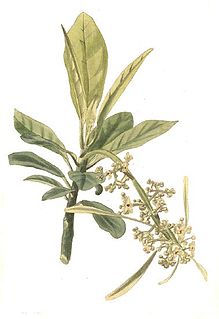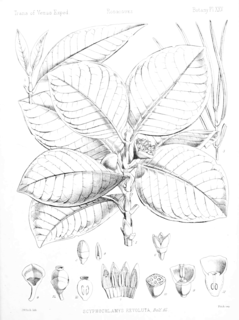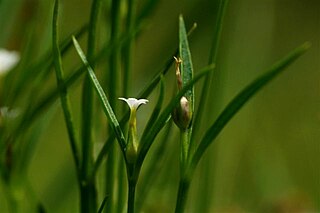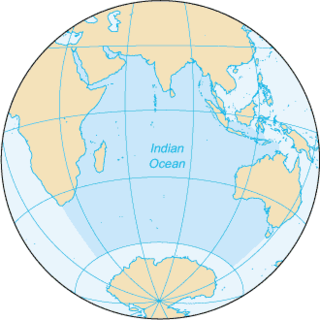
Kalanchoe, or kal-un-KOH-ee, or kal-un-kee, also written Kalanchöe or Kalanchoë, is a genus of about 125 species of tropical, succulent flowering plants in the family Crassulaceae, mainly native to Madagascar and tropical Africa. Kalanchoe was one of the first plants to be sent into space, sent on a resupply to the Soviet Salyut 1 space station in 1971.

Catharanthus is a genus of flowering plants in the dogbane family, Apocynaceae. Like genus Vinca, they are known commonly as periwinkles. There are eight known species. Seven are endemic to Madagascar, though one, C. roseus, is widely naturalized around the world. The eighth species, C. pusillus, is native to India and Sri Lanka. The name Catharanthus comes from the Greek for "pure flower".

Joseph Marie Henry Alfred Perrier de la Bâthie was a French botanist who specialized in the plants of Madagascar.

Ravenala is a genus of flowering plants with a single species, Ravenala madagascariensis, commonly known as traveller's tree or traveller's palm, from Madagascar. It is not a true palm but a member of a monocotyledonous flowering plant family, Strelitziaceae. The genus is closely related to the southern African genus Strelitzia and the South American genus Phenakospermum. Some older classifications include these genera in the banana family (Musaceae). Although it is usually considered to be a single species, four different forms have been distinguished.

Tabernaemontana is a genus of flowering plants in the family Apocynaceae. It has a pan-tropical distribution, found in Asia, Africa, Australia, North America, South America, and a wide assortment of oceanic islands. These plants are evergreen shrubs and small trees growing to 1–15 m tall. The leaves are opposite, 3–25 cm long, with milky sap; hence it is one of the diverse plant genera commonly called "milkwood". The flowers are fragrant, white, 1–5 cm in diameter.

Omphalea is a plant genus of the family Euphorbiaceae first described as a genus in 1759. It is native to tropical parts of the Americas, the West Indies, Asia, Australia, and Africa.

Uapaca is a genus of plant, in the family Phyllanthaceae first described as a genus in 1858. It is the only genus comprised in the subtribe Uapacinae. The genus is native to Africa and Madagascar.
Asteropeia is a genus of flowering plants. The genus contains 8 known species of shrubs and small trees, all endemic to Madagascar. It is the sole genus in family Asteropeiaceae. Members of the family are evergreen trees or shrubs.

The Madagascar spiny forests is an ecoregion in the southwest of Madagascar. The vegetation type is found on poor substrates with low, erratic winter rainfall. The ecoregion contains an outstanding proportion of endemic plant species and is part of the Global 200.

Mimusops is a genus of plants in the family Sapotaceae described as a genus by Linnaeus in 1753.

Pyrostria is a genus of flowering plants in the family Rubiaceae. Most of the species are endemic to Madagascar, others occur on islands in the western Indian Ocean, a few are found in continental Africa, and only six species occur in tropical Southeast Asia.

Piper borbonense is a species of plant in the genus Piper. A close relative of black pepper, its berries are used as a spice known as voatsiperifery, which comes from voa, the Malagasy word for fruit, and tsiperifery, the local name of the plant. A wild pepper, it grows in Madagascar.
Peponidium is a genus of flowering plants in the Rubiaceae family. The genus is endemic to Madagascar, except for Peponidium ovato-oblongum and Peponidium venulosum that are found on the Comoros, and Peponidium carinatum and Peponidium celastroides that are found on the Seychelles.

Jean Marie Bosser, sometimes listed as Jean-Michel Bosser was a French botanist and agricultural engineer who worked extensively in Madagascar and Mauritius.
Secamonopsis is a genus of shrubs in the Apocynaceae. It has only two species, both of which are endemic to Madagascar:

Genianthus is a genus of plants in the Apocynaceae, first described as a genus in 1883. It is native to southern China, the Indian Subcontinent, and Southeast Asia.
Pentopetia is a plant genus in the family Apocynaceae, first described as a genus in 1844.
Pervillaea is a genus of plants in the Milkweed family, Apocynaceae, first described as a genus in 1844. It is native to Mauritius and Madagascar in the Indian Ocean.
- Pervillaea brevirostrisKlack. - Mauritius
- Pervillaea decaryi(Choux) Klack. - Madagascar
- Pervillaea phillipsoniiKlack. - Madagascar
- Pervillaea tomentosaDecne. - Madagascar
- Pervillaea venenata(Baill.) Klack. - Madagascar

Klackenbergia is a genus of flowering plants belonging to the gentian family (Gentianaceae) and the tribe Exaceae. It only contains two species, both endemic to Madagascar. They are notable for their inflorescence with characteristic long bracts and bracteoles and sub-sessile flowers arranged in axillary fascicules at each node.
Exaceae is a flowering plant tribe in the family Gentianaceae. Exaceae comprises about 180 species assigned to eight monophyletic genera, with major centres of endemism in continental Africa, Madagascar and the southern tip of India and Sri Lanka (14 endemic species).
















